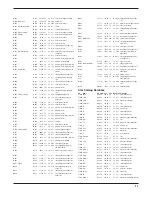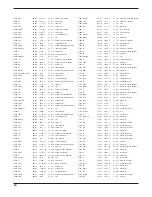
5
only. Stars should rotate about the center of the field of view. For
Altazimuth or Dobsonian telescopes, put a simple index align-
ment mark on your scope to save you time in the future. You can
choose to make the index mark with the telescope aiming either
vertically or horizontally, depending on your choice in the
INSTALL program. A precisely vertical orientation can be deter-
mined by rotating the telescope around the base and looking for
any tube “wobble.” Better yet, use a carpenter’s level. Adjust the
angle until no wobble can be seen while rotating the telescope.
You can also install a “stop” in the rocker box so the telescope
stops at exactly the vertical position. Alternately, a horizontal
orientation can be made by placing the telescope base on a
very level surface, and then leveling the telescope tube with a
carpenter’s level. Mark a line on the telescope bearing and on
the body to use for an index mark.
2. operation
overview
Sky Wizard 2 has eight operating modes. Each mode or func-
tion performs a different task. Pressing the MODE button
shows the current mode. Change to a different mode by
pressing either SELECT button (up or down arrow). The
SELECT buttons are always used for scrolling through the list
of available choices. The UP button advances through the list
in a forward direction, the DOWN button moves backwards.
the operating modes are:
CATALOG Display or choose an object in one of the
catalogs.
ENC TEST Test mode–verifies encoder rotation & correct
installation.
FIND
Tell Sky Wizard to display direction/distance to
the last object chosen in one of the catalogs.
INSTALL
Run when you first install Sky Wizard on your
telescope.
RA DEC
Displays celestial coordinates.
SETUP
Run at the beginning of each observing
session.
SYNC
Tell Sky Wizard that the current object has
been exactly centered – “tweaks” the current
alignment.
TIMER
Use the built-in utility timer.
Power on initialization
When you first turn on Sky Wizard, you need to aim the telescope
to a particular position so the angle of one encoder to the telescope
is known. This step is critical to accuracy. Depending on the type of
mount you have, the display shows one of the following messages:
DEC=0, LEVEL ME, or VERTICAL. Only with a perfect polar align-
ment (EP or GP) does the Sky wizard go directly to
SETUP.
Turn on Sky Wizard. It will briefly display the startup message
ORION SKY WIZARD V 2.00. The numbers displayed are the
software version number. Sky Wizard will display one of the
following depending on the mount type choice you made when
you ran
INSTALL. (See Installation for more information).
SET DEC=0–(Equatorial mount) Set telescope declination to
the 0° index mark on the mechanical setting circles. You must
verify that your mechanical setting circles are EXACT. Aim
telescope at celestial equator, 90° from the pole. (German
Equatorial mountings must have the encoder initialized with
the declination axis set at the east of the meridian zero decli-
nation, the optical tube on the west side.) See Chp 6, page 14
Startup Index Mark for more information.
SET LEVEL ME–(Altazimuth mount type AZ) Aim telescope
tube horizontally to your index mark (telescope aimed at the
horizon if scope base is level). The telescope tube must be
exactly parallel with the bottom of the rocker box. You must
verify that this is exact with a bubble level your first time out.
SET VERTICAL–(Altazimuth mount type AV) Aim telescope
tube vertically to your index mark (telescope aimed directly
overhead if scope base is level). The telescope must be
exactly perpendicular to the bottom of the rocker box. You
must verify that this is exact with a bubble level your first time
out. After you have moved the telescope to the correct initial
position, press ENTER. Sky Wizard will then switch to
SETUP
mode. (If you make a mistake in initializing the mount align-
ment, turn Sky Wizard off and on again to restart. There is no
other way to repeat mount initialization.)
The initialization steps above are critical to the pointing accu-
racy of the Sky Wizard. For example, an error of 1 deg. on the
initialization will result in errors up to 2 deg. Follow the steps
carefully in Chp 1,
Startup Index Mark, page 5.
sEtuP star alignment
Before Sky Wizard can tell you where to point your telescope,
it needs to get its bearings on the sky. You must do this at the
start of each observing session.
SETUP mode automatically
accesses a short list of 30 named navigational stars (listed in
Chp 6, page 14). The brightest stars from both the Northern
and Southern hemispheres are included. These familiar bright
stars cover the sky so that at least two are visible at any time.
You’ll need to point your telescope to two known stars, tell Sky
Wizard which ones they are, and you’re ready to go.
to perform the setup star alignment:
1. Pick a bright known star from the list and center it in the eye-
piece.
2. Press MODE. If
SETUP is not displayed, use the arrow
keys to display
SETUP. Press ENTER.
3. Scroll through the star list to find the name of the star that
is centered in the eyepiece, then press ENTER.
4. Choose another bright star for the second alignment star
and repeat step 3. For best results the two stars should be
at least 60° apart. Avoid stars near the pole.
Note: Only one star sighting is required for perfectly
polar-aligned equatorial telescopes; however a second
sighting is recommended.















